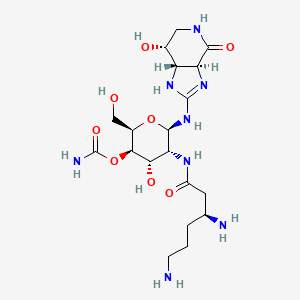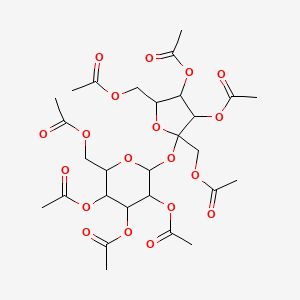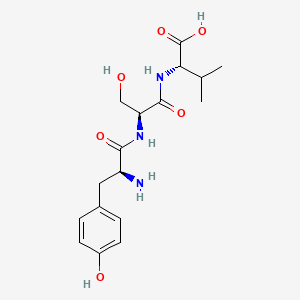
Sulfisoxazole
Vue d'ensemble
Description
Sulfisoxazole is a sulfonamide antibiotic used to prevent and treat a variety of bacterial infections. It is effective against a wide range of gram-positive and gram-negative organisms. This compound works by inhibiting bacterial synthesis of dihydrofolic acid, which is essential for bacterial growth and replication .
Mécanisme D'action
Target of Action
Sulfisoxazole is a sulfonamide antibiotic that primarily targets the enzyme dihydropteroate synthetase . This enzyme plays a crucial role in the synthesis of dihydrofolic acid, a vital component for bacterial growth and survival .
Mode of Action
This compound acts as a competitive inhibitor of dihydropteroate synthetase . It inhibits bacterial synthesis of dihydrofolic acid by preventing the condensation of the pteridine with para-aminobenzoic acid (PABA), a substrate of the enzyme dihydropteroate synthetase . This inhibition disrupts the production of dihydrofolic acid, thereby hindering bacterial growth .
Biochemical Pathways
The primary biochemical pathway affected by this compound is the microbial folate biosynthesis pathway . By inhibiting dihydropteroate synthetase, this compound blocks the production of 7,8-dihydropteroate from para-aminobenzoic acid (PABA) and dihydropterin pyrophosphate (DHPP) . This disruption in the folate pathway leads to a deficiency of tetrahydrofolate, a coenzyme required for the synthesis of purines and pyrimidines, which are essential for DNA replication .
Pharmacokinetics
This compound exhibits a two-compartment open-system model pharmacokinetic profile . The drug distributes rapidly from the central compartment, with a calculated volume of distribution ranging from 13 to 20% of body weight . This compound is eliminated from the body at a fairly rapid rate, with an apparent half-life range of 4.6-6.9 hours . It is ultimately eliminated from the body solely by means of urinary excretion, with a mean of 54% of the dose excreted as “free” drug and the remainder as the N4-acetylated biotransformation product .
Result of Action
The primary result of this compound’s action is the inhibition of bacterial growth . By blocking the synthesis of dihydrofolic acid, this compound prevents bacteria from producing the necessary components for DNA replication . This leads to a halt in bacterial proliferation, aiding in the resolution of bacterial infections .
Action Environment
The action of this compound can be influenced by various environmental factors. For instance, high levels of the drug are achieved in pleural, peritoneal, synovial, and ocular fluids . Its antibacterial action is inhibited by pus . Additionally, the pH of the environment can affect the ionization of this compound, potentially influencing its absorption and efficacy .
Applications De Recherche Scientifique
Sulfisoxazole has a wide range of applications in scientific research:
Chemistry: It is used as a model compound in studies of sulfonamide chemistry and reactivity.
Biology: this compound is used to study bacterial resistance mechanisms and the effects of antibiotics on bacterial growth.
Industry: this compound is used in the pharmaceutical industry for the production of antibacterial drugs.
Analyse Biochimique
Biochemical Properties
Sulfisoxazole plays a significant role in biochemical reactions by acting as a competitive inhibitor of the enzyme dihydropteroate synthetase. This enzyme is essential for the bacterial synthesis of dihydrofolic acid. By inhibiting this enzyme, this compound prevents the condensation of pteridine with para-aminobenzoic acid (PABA), thereby halting the production of dihydrofolic acid . This inhibition disrupts the bacterial folate pathway, which is vital for DNA, RNA, and protein synthesis.
Cellular Effects
This compound affects various types of cells and cellular processes. It primarily targets bacterial cells, inhibiting their growth and proliferation. By blocking the synthesis of dihydrofolic acid, this compound disrupts the production of nucleotides, which are essential for DNA replication and cell division . This leads to the inhibition of bacterial growth and the eventual death of the bacterial cells. Additionally, this compound can influence cell signaling pathways and gene expression by altering the availability of folate derivatives required for these processes .
Molecular Mechanism
At the molecular level, this compound exerts its effects by binding to the active site of dihydropteroate synthetase, thereby competitively inhibiting the enzyme. This binding prevents the enzyme from interacting with its natural substrate, PABA, and subsequently inhibits the synthesis of dihydrofolic acid . The inhibition of dihydrofolic acid synthesis leads to a depletion of tetrahydrofolate, a cofactor required for the synthesis of purines, thymidine, and certain amino acids. This disruption in nucleotide synthesis ultimately hampers bacterial DNA replication and cell division .
Temporal Effects in Laboratory Settings
In laboratory settings, the effects of this compound can change over time. The stability of this compound is influenced by factors such as pH, temperature, and light exposure. Studies have shown that this compound remains stable under acidic conditions but can degrade under alkaline conditions . Over time, the degradation of this compound can lead to a reduction in its antibacterial efficacy. Long-term exposure to this compound in in vitro and in vivo studies has shown that bacterial cells can develop resistance mechanisms, such as the overproduction of PABA or mutations in dihydropteroate synthetase .
Dosage Effects in Animal Models
The effects of this compound vary with different dosages in animal models. At therapeutic doses, this compound effectively inhibits bacterial growth and treats infections. At higher doses, this compound can exhibit toxic effects, such as hepatotoxicity and nephrotoxicity . Studies in animal models have shown that this compound can cause liver and kidney damage at high doses, leading to elevated levels of liver enzymes and renal dysfunction . Additionally, prolonged exposure to high doses of this compound can result in hematological abnormalities, such as anemia and leukopenia .
Metabolic Pathways
This compound is primarily metabolized in the liver through acetylation and glucuronidation pathways. The major metabolite of this compound is N4-acetylthis compound, which is excreted in the urine . The metabolic pathways of this compound involve enzymes such as N-acetyltransferase and UDP-glucuronosyltransferase . These enzymes facilitate the conjugation of this compound with acetyl and glucuronide groups, enhancing its solubility and excretion. The metabolism of this compound can also affect metabolic flux and metabolite levels, influencing the overall pharmacokinetics of the drug .
Transport and Distribution
This compound is transported and distributed within cells and tissues through passive diffusion and active transport mechanisms. It is widely distributed throughout the body, including the liver, kidneys, lungs, and cerebrospinal fluid . This compound can cross the blood-brain barrier and achieve therapeutic concentrations in the central nervous system. The transport of this compound is facilitated by transporters such as organic anion transporters (OATs) and multidrug resistance proteins (MRPs) . These transporters play a crucial role in the uptake and efflux of this compound, affecting its localization and accumulation in different tissues .
Subcellular Localization
This compound exhibits subcellular localization within bacterial cells, primarily targeting the cytoplasm where dihydropteroate synthetase is located . The compound does not require specific targeting signals or post-translational modifications for its activity. Instead, it diffuses into the bacterial cell and interacts with the enzyme directly in the cytoplasm . The subcellular localization of this compound is crucial for its inhibitory effects on dihydropteroate synthetase and subsequent disruption of folate metabolism .
Méthodes De Préparation
Synthetic Routes and Reaction Conditions: The preparation of sulfisoxazole involves a condensation reaction where 3-aminoisoxazole is reacted with p-acetamido-benzenesulfonyl chloride in the presence of toluene and pyridine. This reaction is typically carried out over 20-24 hours. The resulting product undergoes hydrolysis with liquid caustic soda, followed by a salt-forming reaction to obtain this compound sodium .
Industrial Production Methods: Industrial production of this compound follows similar synthetic routes but on a larger scale. The process involves careful control of reaction conditions to ensure high yield and purity. The final product is often crystallized and purified to meet pharmaceutical standards .
Analyse Des Réactions Chimiques
Types of Reactions: Sulfisoxazole undergoes various chemical reactions, including:
Oxidation: this compound can be oxidized under specific conditions to form different derivatives.
Reduction: It can also undergo reduction reactions, although these are less common.
Substitution: this compound can participate in substitution reactions, particularly involving the sulfonamide group.
Common Reagents and Conditions:
Oxidation: Common oxidizing agents include hydrogen peroxide and potassium permanganate.
Reduction: Reducing agents such as sodium borohydride can be used.
Substitution: Reagents like alkyl halides and acyl chlorides are often used in substitution reactions.
Major Products: The major products formed from these reactions depend on the specific conditions and reagents used. For example, oxidation can lead to the formation of sulfone derivatives .
Comparaison Avec Des Composés Similaires
Sulfamethoxazole: Another sulfonamide antibiotic with a similar mechanism of action but different pharmacokinetics.
Sulfadiazine: Used primarily in the treatment of toxoplasmosis.
Sulfapyridine: Used in the treatment of dermatitis herpetiformis.
Uniqueness: Sulfisoxazole is unique in its short-acting nature and its effectiveness against a broad spectrum of bacterial species. It is particularly useful in combination therapies to enhance antibacterial efficacy .
Propriétés
IUPAC Name |
4-amino-N-(3,4-dimethyl-1,2-oxazol-5-yl)benzenesulfonamide | |
|---|---|---|
| Source | PubChem | |
| URL | https://pubchem.ncbi.nlm.nih.gov | |
| Description | Data deposited in or computed by PubChem | |
InChI |
InChI=1S/C11H13N3O3S/c1-7-8(2)13-17-11(7)14-18(15,16)10-5-3-9(12)4-6-10/h3-6,14H,12H2,1-2H3 | |
| Source | PubChem | |
| URL | https://pubchem.ncbi.nlm.nih.gov | |
| Description | Data deposited in or computed by PubChem | |
InChI Key |
NHUHCSRWZMLRLA-UHFFFAOYSA-N | |
| Source | PubChem | |
| URL | https://pubchem.ncbi.nlm.nih.gov | |
| Description | Data deposited in or computed by PubChem | |
Canonical SMILES |
CC1=C(ON=C1C)NS(=O)(=O)C2=CC=C(C=C2)N | |
| Source | PubChem | |
| URL | https://pubchem.ncbi.nlm.nih.gov | |
| Description | Data deposited in or computed by PubChem | |
Molecular Formula |
C11H13N3O3S | |
| Record name | SULFISOXAZOLE | |
| Source | CAMEO Chemicals | |
| URL | https://cameochemicals.noaa.gov/chemical/21051 | |
| Description | CAMEO Chemicals is a chemical database designed for people who are involved in hazardous material incident response and planning. CAMEO Chemicals contains a library with thousands of datasheets containing response-related information and recommendations for hazardous materials that are commonly transported, used, or stored in the United States. CAMEO Chemicals was developed by the National Oceanic and Atmospheric Administration's Office of Response and Restoration in partnership with the Environmental Protection Agency's Office of Emergency Management. | |
| Explanation | CAMEO Chemicals and all other CAMEO products are available at no charge to those organizations and individuals (recipients) responsible for the safe handling of chemicals. However, some of the chemical data itself is subject to the copyright restrictions of the companies or organizations that provided the data. | |
| Source | PubChem | |
| URL | https://pubchem.ncbi.nlm.nih.gov | |
| Description | Data deposited in or computed by PubChem | |
Related CAS |
2200-44-4 (mono-hydrochloride salt), 6155-81-3 (mono-lithium salt) | |
| Record name | Sulfisoxazole [USP:JAN] | |
| Source | ChemIDplus | |
| URL | https://pubchem.ncbi.nlm.nih.gov/substance/?source=chemidplus&sourceid=0000127695 | |
| Description | ChemIDplus is a free, web search system that provides access to the structure and nomenclature authority files used for the identification of chemical substances cited in National Library of Medicine (NLM) databases, including the TOXNET system. | |
DSSTOX Substance ID |
DTXSID6021292 | |
| Record name | Sulfisoxazole | |
| Source | EPA DSSTox | |
| URL | https://comptox.epa.gov/dashboard/DTXSID6021292 | |
| Description | DSSTox provides a high quality public chemistry resource for supporting improved predictive toxicology. | |
Molecular Weight |
267.31 g/mol | |
| Source | PubChem | |
| URL | https://pubchem.ncbi.nlm.nih.gov | |
| Description | Data deposited in or computed by PubChem | |
Physical Description |
Sulfisoxazole is an odorless white to yellowish crystalline powder. Slightly bitter taste. Acid to litmus. (NTP, 1992), Solid | |
| Record name | SULFISOXAZOLE | |
| Source | CAMEO Chemicals | |
| URL | https://cameochemicals.noaa.gov/chemical/21051 | |
| Description | CAMEO Chemicals is a chemical database designed for people who are involved in hazardous material incident response and planning. CAMEO Chemicals contains a library with thousands of datasheets containing response-related information and recommendations for hazardous materials that are commonly transported, used, or stored in the United States. CAMEO Chemicals was developed by the National Oceanic and Atmospheric Administration's Office of Response and Restoration in partnership with the Environmental Protection Agency's Office of Emergency Management. | |
| Explanation | CAMEO Chemicals and all other CAMEO products are available at no charge to those organizations and individuals (recipients) responsible for the safe handling of chemicals. However, some of the chemical data itself is subject to the copyright restrictions of the companies or organizations that provided the data. | |
| Record name | Sulfisoxazole | |
| Source | Human Metabolome Database (HMDB) | |
| URL | http://www.hmdb.ca/metabolites/HMDB0014408 | |
| Description | The Human Metabolome Database (HMDB) is a freely available electronic database containing detailed information about small molecule metabolites found in the human body. | |
| Explanation | HMDB is offered to the public as a freely available resource. Use and re-distribution of the data, in whole or in part, for commercial purposes requires explicit permission of the authors and explicit acknowledgment of the source material (HMDB) and the original publication (see the HMDB citing page). We ask that users who download significant portions of the database cite the HMDB paper in any resulting publications. | |
Solubility |
>40.1 [ug/mL] (The mean of the results at pH 7.4), less than 1 mg/mL at 72.5 °F (NTP, 1992), White to off-white, odorless, crystalline powder. Sol in alcohol; freely sol in water. /Diethanolamine salt/, Soluble in alcohol, SOL IN DIETHYL ETHER (1 IN 800); SOL IN 5% AQ SODIUM BICARBONATE (1 IN 30), 1 G IN ABOUT 6700 ML WATER; SOL IN DIL HYDROCHLORIC ACID; 1 G IN ABOUT 10 ML BOILING ALCOHOL, In water, 300 mg/L at 37 °C, pH 4.5, 3.13e-01 g/L | |
| Record name | SID859862 | |
| Source | Burnham Center for Chemical Genomics | |
| URL | https://pubchem.ncbi.nlm.nih.gov/bioassay/1996#section=Data-Table | |
| Description | Aqueous solubility in buffer at pH 7.4 | |
| Record name | SULFISOXAZOLE | |
| Source | CAMEO Chemicals | |
| URL | https://cameochemicals.noaa.gov/chemical/21051 | |
| Description | CAMEO Chemicals is a chemical database designed for people who are involved in hazardous material incident response and planning. CAMEO Chemicals contains a library with thousands of datasheets containing response-related information and recommendations for hazardous materials that are commonly transported, used, or stored in the United States. CAMEO Chemicals was developed by the National Oceanic and Atmospheric Administration's Office of Response and Restoration in partnership with the Environmental Protection Agency's Office of Emergency Management. | |
| Explanation | CAMEO Chemicals and all other CAMEO products are available at no charge to those organizations and individuals (recipients) responsible for the safe handling of chemicals. However, some of the chemical data itself is subject to the copyright restrictions of the companies or organizations that provided the data. | |
| Record name | Sulfisoxazole | |
| Source | DrugBank | |
| URL | https://www.drugbank.ca/drugs/DB00263 | |
| Description | The DrugBank database is a unique bioinformatics and cheminformatics resource that combines detailed drug (i.e. chemical, pharmacological and pharmaceutical) data with comprehensive drug target (i.e. sequence, structure, and pathway) information. | |
| Explanation | Creative Common's Attribution-NonCommercial 4.0 International License (http://creativecommons.org/licenses/by-nc/4.0/legalcode) | |
| Record name | SULFISOXAZOLE | |
| Source | Hazardous Substances Data Bank (HSDB) | |
| URL | https://pubchem.ncbi.nlm.nih.gov/source/hsdb/797 | |
| Description | The Hazardous Substances Data Bank (HSDB) is a toxicology database that focuses on the toxicology of potentially hazardous chemicals. It provides information on human exposure, industrial hygiene, emergency handling procedures, environmental fate, regulatory requirements, nanomaterials, and related areas. The information in HSDB has been assessed by a Scientific Review Panel. | |
| Record name | Sulfisoxazole | |
| Source | Human Metabolome Database (HMDB) | |
| URL | http://www.hmdb.ca/metabolites/HMDB0014408 | |
| Description | The Human Metabolome Database (HMDB) is a freely available electronic database containing detailed information about small molecule metabolites found in the human body. | |
| Explanation | HMDB is offered to the public as a freely available resource. Use and re-distribution of the data, in whole or in part, for commercial purposes requires explicit permission of the authors and explicit acknowledgment of the source material (HMDB) and the original publication (see the HMDB citing page). We ask that users who download significant portions of the database cite the HMDB paper in any resulting publications. | |
Mechanism of Action |
Sulfisoxazole is a competitive inhibitor of the enzyme dihydropteroate synthetase. It inhibits bacterial synthesis of dihydrofolic acid by preventing the condensation of the pteridine with para-aminobenzoic acid (PABA), a substrate of the enzyme dihydropteroate synthetase. The inhibited reaction is necessary in these organisms for the synthesis of folic acid., The sulfonamides are bacteriostatic agents and the spectrum of activity is similar for all. Sulfonamides inhibit bacterial synthesis of dihydrofolic acid by preventing the condensation of the pteridine with aminobenzoic acid through competitive inhibition of the enzyme dihydropteroate synthetase. Resistant strains have altered dihydropteroate synthetase with reduced affinity for sulfonamides or produce increased quantities of aminobenzoic acid., Sulfonamides are usually bacteriostatic in action. Sulfonamides interfere with the utilization of p-aminobenzoic acid (PABA) in the biosynthesis of tetrahydrofolic acid (the reduced form of folic acid) cofactors in susceptible bacteria. Sulfonamides are structural analogs of PABA and appear to interfere with PABA utilization by competitively inhibiting the enzyme dihydropteroate synthase, which catalyzes the formation of dihydropteroic acid (a precursor of tetrahydrofolic acid) from PABA and pteridine; however, other mechanism(s) affecting the biosynthetic pathway also may be involved. Compounds such as pyrimethamine and trimethoprim, which block later stages in the synthesis of folic acid, act synergistically with sulfonamides. Only microorganisms that synthesize their own folic acid are inhibited by sulfonamides; animal cells and bacteria which are capable of utilizing folic acid precursors or preformed folic acid are not affected by these drugs. The antibacterial activity of the sulfonamides is reportedly decreased in the presence of blood or purulent body exudates. /Sulfonamides/ | |
| Record name | Sulfisoxazole | |
| Source | DrugBank | |
| URL | https://www.drugbank.ca/drugs/DB00263 | |
| Description | The DrugBank database is a unique bioinformatics and cheminformatics resource that combines detailed drug (i.e. chemical, pharmacological and pharmaceutical) data with comprehensive drug target (i.e. sequence, structure, and pathway) information. | |
| Explanation | Creative Common's Attribution-NonCommercial 4.0 International License (http://creativecommons.org/licenses/by-nc/4.0/legalcode) | |
| Record name | SULFISOXAZOLE | |
| Source | Hazardous Substances Data Bank (HSDB) | |
| URL | https://pubchem.ncbi.nlm.nih.gov/source/hsdb/797 | |
| Description | The Hazardous Substances Data Bank (HSDB) is a toxicology database that focuses on the toxicology of potentially hazardous chemicals. It provides information on human exposure, industrial hygiene, emergency handling procedures, environmental fate, regulatory requirements, nanomaterials, and related areas. The information in HSDB has been assessed by a Scientific Review Panel. | |
Color/Form |
Colorless prisms, White to slightly yellowish crystalline powder | |
CAS No. |
127-69-5 | |
| Record name | SULFISOXAZOLE | |
| Source | CAMEO Chemicals | |
| URL | https://cameochemicals.noaa.gov/chemical/21051 | |
| Description | CAMEO Chemicals is a chemical database designed for people who are involved in hazardous material incident response and planning. CAMEO Chemicals contains a library with thousands of datasheets containing response-related information and recommendations for hazardous materials that are commonly transported, used, or stored in the United States. CAMEO Chemicals was developed by the National Oceanic and Atmospheric Administration's Office of Response and Restoration in partnership with the Environmental Protection Agency's Office of Emergency Management. | |
| Explanation | CAMEO Chemicals and all other CAMEO products are available at no charge to those organizations and individuals (recipients) responsible for the safe handling of chemicals. However, some of the chemical data itself is subject to the copyright restrictions of the companies or organizations that provided the data. | |
| Record name | Sulfisoxazole | |
| Source | CAS Common Chemistry | |
| URL | https://commonchemistry.cas.org/detail?cas_rn=127-69-5 | |
| Description | CAS Common Chemistry is an open community resource for accessing chemical information. Nearly 500,000 chemical substances from CAS REGISTRY cover areas of community interest, including common and frequently regulated chemicals, and those relevant to high school and undergraduate chemistry classes. This chemical information, curated by our expert scientists, is provided in alignment with our mission as a division of the American Chemical Society. | |
| Explanation | The data from CAS Common Chemistry is provided under a CC-BY-NC 4.0 license, unless otherwise stated. | |
| Record name | Sulfisoxazole [USP:JAN] | |
| Source | ChemIDplus | |
| URL | https://pubchem.ncbi.nlm.nih.gov/substance/?source=chemidplus&sourceid=0000127695 | |
| Description | ChemIDplus is a free, web search system that provides access to the structure and nomenclature authority files used for the identification of chemical substances cited in National Library of Medicine (NLM) databases, including the TOXNET system. | |
| Record name | Sulfisoxazole | |
| Source | DrugBank | |
| URL | https://www.drugbank.ca/drugs/DB00263 | |
| Description | The DrugBank database is a unique bioinformatics and cheminformatics resource that combines detailed drug (i.e. chemical, pharmacological and pharmaceutical) data with comprehensive drug target (i.e. sequence, structure, and pathway) information. | |
| Explanation | Creative Common's Attribution-NonCommercial 4.0 International License (http://creativecommons.org/licenses/by-nc/4.0/legalcode) | |
| Record name | sulfisoxazole | |
| Source | DTP/NCI | |
| URL | https://dtp.cancer.gov/dtpstandard/servlet/dwindex?searchtype=NSC&outputformat=html&searchlist=757343 | |
| Description | The NCI Development Therapeutics Program (DTP) provides services and resources to the academic and private-sector research communities worldwide to facilitate the discovery and development of new cancer therapeutic agents. | |
| Explanation | Unless otherwise indicated, all text within NCI products is free of copyright and may be reused without our permission. Credit the National Cancer Institute as the source. | |
| Record name | sulfisoxazole | |
| Source | DTP/NCI | |
| URL | https://dtp.cancer.gov/dtpstandard/servlet/dwindex?searchtype=NSC&outputformat=html&searchlist=38588 | |
| Description | The NCI Development Therapeutics Program (DTP) provides services and resources to the academic and private-sector research communities worldwide to facilitate the discovery and development of new cancer therapeutic agents. | |
| Explanation | Unless otherwise indicated, all text within NCI products is free of copyright and may be reused without our permission. Credit the National Cancer Institute as the source. | |
| Record name | sulfisoxazole | |
| Source | DTP/NCI | |
| URL | https://dtp.cancer.gov/dtpstandard/servlet/dwindex?searchtype=NSC&outputformat=html&searchlist=33807 | |
| Description | The NCI Development Therapeutics Program (DTP) provides services and resources to the academic and private-sector research communities worldwide to facilitate the discovery and development of new cancer therapeutic agents. | |
| Explanation | Unless otherwise indicated, all text within NCI products is free of copyright and may be reused without our permission. Credit the National Cancer Institute as the source. | |
| Record name | sulfisoxazole | |
| Source | DTP/NCI | |
| URL | https://dtp.cancer.gov/dtpstandard/servlet/dwindex?searchtype=NSC&outputformat=html&searchlist=13120 | |
| Description | The NCI Development Therapeutics Program (DTP) provides services and resources to the academic and private-sector research communities worldwide to facilitate the discovery and development of new cancer therapeutic agents. | |
| Explanation | Unless otherwise indicated, all text within NCI products is free of copyright and may be reused without our permission. Credit the National Cancer Institute as the source. | |
| Record name | Benzenesulfonamide, 4-amino-N-(3,4-dimethyl-5-isoxazolyl)- | |
| Source | EPA Chemicals under the TSCA | |
| URL | https://www.epa.gov/chemicals-under-tsca | |
| Description | EPA Chemicals under the Toxic Substances Control Act (TSCA) collection contains information on chemicals and their regulations under TSCA, including non-confidential content from the TSCA Chemical Substance Inventory and Chemical Data Reporting. | |
| Record name | Sulfisoxazole | |
| Source | EPA DSSTox | |
| URL | https://comptox.epa.gov/dashboard/DTXSID6021292 | |
| Description | DSSTox provides a high quality public chemistry resource for supporting improved predictive toxicology. | |
| Record name | Sulfafurazole | |
| Source | European Chemicals Agency (ECHA) | |
| URL | https://echa.europa.eu/substance-information/-/substanceinfo/100.004.418 | |
| Description | The European Chemicals Agency (ECHA) is an agency of the European Union which is the driving force among regulatory authorities in implementing the EU's groundbreaking chemicals legislation for the benefit of human health and the environment as well as for innovation and competitiveness. | |
| Explanation | Use of the information, documents and data from the ECHA website is subject to the terms and conditions of this Legal Notice, and subject to other binding limitations provided for under applicable law, the information, documents and data made available on the ECHA website may be reproduced, distributed and/or used, totally or in part, for non-commercial purposes provided that ECHA is acknowledged as the source: "Source: European Chemicals Agency, http://echa.europa.eu/". Such acknowledgement must be included in each copy of the material. ECHA permits and encourages organisations and individuals to create links to the ECHA website under the following cumulative conditions: Links can only be made to webpages that provide a link to the Legal Notice page. | |
| Record name | SULFISOXAZOLE | |
| Source | FDA Global Substance Registration System (GSRS) | |
| URL | https://gsrs.ncats.nih.gov/ginas/app/beta/substances/740T4C525W | |
| Description | The FDA Global Substance Registration System (GSRS) enables the efficient and accurate exchange of information on what substances are in regulated products. Instead of relying on names, which vary across regulatory domains, countries, and regions, the GSRS knowledge base makes it possible for substances to be defined by standardized, scientific descriptions. | |
| Explanation | Unless otherwise noted, the contents of the FDA website (www.fda.gov), both text and graphics, are not copyrighted. They are in the public domain and may be republished, reprinted and otherwise used freely by anyone without the need to obtain permission from FDA. Credit to the U.S. Food and Drug Administration as the source is appreciated but not required. | |
| Record name | SULFISOXAZOLE | |
| Source | Hazardous Substances Data Bank (HSDB) | |
| URL | https://pubchem.ncbi.nlm.nih.gov/source/hsdb/797 | |
| Description | The Hazardous Substances Data Bank (HSDB) is a toxicology database that focuses on the toxicology of potentially hazardous chemicals. It provides information on human exposure, industrial hygiene, emergency handling procedures, environmental fate, regulatory requirements, nanomaterials, and related areas. The information in HSDB has been assessed by a Scientific Review Panel. | |
| Record name | Sulfisoxazole | |
| Source | Human Metabolome Database (HMDB) | |
| URL | http://www.hmdb.ca/metabolites/HMDB0014408 | |
| Description | The Human Metabolome Database (HMDB) is a freely available electronic database containing detailed information about small molecule metabolites found in the human body. | |
| Explanation | HMDB is offered to the public as a freely available resource. Use and re-distribution of the data, in whole or in part, for commercial purposes requires explicit permission of the authors and explicit acknowledgment of the source material (HMDB) and the original publication (see the HMDB citing page). We ask that users who download significant portions of the database cite the HMDB paper in any resulting publications. | |
Melting Point |
383 to 388 °F (NTP, 1992), 194 °C, MP: 191 °C, MP: 195-198 °C | |
| Record name | SULFISOXAZOLE | |
| Source | CAMEO Chemicals | |
| URL | https://cameochemicals.noaa.gov/chemical/21051 | |
| Description | CAMEO Chemicals is a chemical database designed for people who are involved in hazardous material incident response and planning. CAMEO Chemicals contains a library with thousands of datasheets containing response-related information and recommendations for hazardous materials that are commonly transported, used, or stored in the United States. CAMEO Chemicals was developed by the National Oceanic and Atmospheric Administration's Office of Response and Restoration in partnership with the Environmental Protection Agency's Office of Emergency Management. | |
| Explanation | CAMEO Chemicals and all other CAMEO products are available at no charge to those organizations and individuals (recipients) responsible for the safe handling of chemicals. However, some of the chemical data itself is subject to the copyright restrictions of the companies or organizations that provided the data. | |
| Record name | Sulfisoxazole | |
| Source | DrugBank | |
| URL | https://www.drugbank.ca/drugs/DB00263 | |
| Description | The DrugBank database is a unique bioinformatics and cheminformatics resource that combines detailed drug (i.e. chemical, pharmacological and pharmaceutical) data with comprehensive drug target (i.e. sequence, structure, and pathway) information. | |
| Explanation | Creative Common's Attribution-NonCommercial 4.0 International License (http://creativecommons.org/licenses/by-nc/4.0/legalcode) | |
| Record name | SULFISOXAZOLE | |
| Source | Hazardous Substances Data Bank (HSDB) | |
| URL | https://pubchem.ncbi.nlm.nih.gov/source/hsdb/797 | |
| Description | The Hazardous Substances Data Bank (HSDB) is a toxicology database that focuses on the toxicology of potentially hazardous chemicals. It provides information on human exposure, industrial hygiene, emergency handling procedures, environmental fate, regulatory requirements, nanomaterials, and related areas. The information in HSDB has been assessed by a Scientific Review Panel. | |
| Record name | Sulfisoxazole | |
| Source | Human Metabolome Database (HMDB) | |
| URL | http://www.hmdb.ca/metabolites/HMDB0014408 | |
| Description | The Human Metabolome Database (HMDB) is a freely available electronic database containing detailed information about small molecule metabolites found in the human body. | |
| Explanation | HMDB is offered to the public as a freely available resource. Use and re-distribution of the data, in whole or in part, for commercial purposes requires explicit permission of the authors and explicit acknowledgment of the source material (HMDB) and the original publication (see the HMDB citing page). We ask that users who download significant portions of the database cite the HMDB paper in any resulting publications. | |
Retrosynthesis Analysis
AI-Powered Synthesis Planning: Our tool employs the Template_relevance Pistachio, Template_relevance Bkms_metabolic, Template_relevance Pistachio_ringbreaker, Template_relevance Reaxys, Template_relevance Reaxys_biocatalysis model, leveraging a vast database of chemical reactions to predict feasible synthetic routes.
One-Step Synthesis Focus: Specifically designed for one-step synthesis, it provides concise and direct routes for your target compounds, streamlining the synthesis process.
Accurate Predictions: Utilizing the extensive PISTACHIO, BKMS_METABOLIC, PISTACHIO_RINGBREAKER, REAXYS, REAXYS_BIOCATALYSIS database, our tool offers high-accuracy predictions, reflecting the latest in chemical research and data.
Strategy Settings
| Precursor scoring | Relevance Heuristic |
|---|---|
| Min. plausibility | 0.01 |
| Model | Template_relevance |
| Template Set | Pistachio/Bkms_metabolic/Pistachio_ringbreaker/Reaxys/Reaxys_biocatalysis |
| Top-N result to add to graph | 6 |
Feasible Synthetic Routes
Q1: How does sulfisoxazole exert its antibacterial effect?
A1: this compound, like other sulfonamides, acts as a competitive inhibitor of dihydropteroate synthase, an enzyme crucial for folic acid synthesis in bacteria. [, ] This inhibition disrupts the production of essential nucleic acids, ultimately hindering bacterial growth and proliferation. [, , , ]
Q2: Does this compound impact the growth rate of Mycobacterium tuberculosis?
A2: Yes, research demonstrates that this compound delays the generation time of Mycobacterium tuberculosis in a concentration-dependent manner. [] This delayed generation time likely stems from the inhibition of essential cell material synthesis, such as purine derivatives. []
Q3: What is the molecular formula and weight of this compound?
A4: The molecular formula of this compound is C11H13N3O3S, and its molecular weight is 267.3 g/mol. [, ]
Q4: What spectroscopic data is available for characterizing this compound?
A5: High-performance liquid chromatography (HPLC) with UV detection is a widely employed technique for separating and quantifying this compound in biological samples like plasma. [] Thin layer chromatography (TLC) can be utilized as a complementary technique to assess the purity of this compound and detect manufacturing impurities. []
Q5: How does protein binding influence the pharmacokinetics of this compound?
A6: Studies in rats have shown a strong link between the serum protein binding of this compound and its clearance. [] Increased serum free fractions of this compound correlate with higher total, metabolic, and renal clearances. [, , , ] The unbound renal clearance of this compound is notably reduced in renal transplant patients and shows a strong correlation with creatinine clearance. []
Q6: What is the impact of age on the pharmacokinetics of this compound?
A7: Pharmacokinetic studies have observed higher plasma levels of this compound in elderly subjects compared to younger individuals following oral administration. [] This difference is attributed to diminished renal function, leading to a longer plasma half-life and decreased total body and renal clearances in the elderly population. []
Q7: How is this compound metabolized?
A8: One of the primary metabolic pathways of this compound is acetylation, resulting in the formation of N4-acetyl this compound. [, ] This metabolic process is particularly relevant in patients with impaired renal function, as the accumulation of the N4-acetyl metabolite in urine can potentially exceed its solubility. []
Q8: What infections has this compound been used to treat?
A10: this compound has been employed in the treatment of various bacterial infections, including urinary tract infections, otitis media, plague, Haemophilus influenzae meningitis, and chancroid. [, , , , , , ]
Q9: Has this compound shown efficacy in preventing Pneumocystis carinii pneumonitis?
A11: An animal study indicated a synergistic effect when erythromycin and this compound were co-administered to immunosuppressed rats, effectively preventing Pneumocystis carinii pneumonitis in 90% of the animals. [] This combination also demonstrated therapeutic benefits in rats with established infections. []
Q10: Does this compound interact with other drugs?
A13: this compound has shown interaction with propofol in animal models, enhancing propofol's anesthetic effects. [] This interaction doesn't appear to be related to changes in protein binding or plasma concentrations. []
Q11: Does the use of this compound raise concerns regarding bilirubin displacement in newborns?
A14: Research indicates that this compound can displace bilirubin from albumin, potentially increasing the risk of kernicterus in newborns, particularly those with jaundice. [, ] This displacement effect has been observed both in vitro and in vivo, raising concerns about the use of this compound in this population. []
Q12: Is there evidence of antimicrobial resistance to this compound?
A15: Yes, antimicrobial resistance to this compound is a growing concern. Studies have reported widespread resistance to this compound in Escherichia coli and Salmonella isolates from livestock and poultry. [, , , ] This highlights the need for responsible antimicrobial stewardship to minimize the development and spread of resistance. [, ]
Q13: What are the potential adverse effects associated with this compound?
A16: While generally considered safe, this compound can cause adverse reactions, with allergic responses being the most common. [, ] These reactions can manifest as skin rashes, eosinophilia, and drug fever. [] Rare but serious reactions have also been reported. [, ]
Q14: Has this compound demonstrated carcinogenic potential in animal studies?
A17: In a bioassay conducted on rats and mice, this compound administration via gavage did not result in a statistically significant increase in tumor incidence compared to control groups. [] This suggests that this compound might not possess a significant carcinogenic risk under the specific conditions of this study.
Q15: Does this compound have any potential applications beyond its antibacterial properties?
A18: Recent research suggests that this compound might hold promise in cancer treatment. Studies have shown that it can inhibit tumor growth and metastasis in breast cancer models, potentially by modulating the immune response and inhibiting exosomal PD-L1. [, ] Further research is needed to explore these promising avenues.
Q16: Could this compound play a role in addressing cancer-associated cachexia?
A19: Preliminary studies in mouse models indicate that this compound administration might partially mitigate cancer-induced weight loss by preserving fat mass. [] This effect is attributed to the potential inhibition of lipolysis. [] Further research is necessary to validate these findings and determine the clinical relevance of this compound in cachexia management.
Avertissement et informations sur les produits de recherche in vitro
Veuillez noter que tous les articles et informations sur les produits présentés sur BenchChem sont destinés uniquement à des fins informatives. Les produits disponibles à l'achat sur BenchChem sont spécifiquement conçus pour des études in vitro, qui sont réalisées en dehors des organismes vivants. Les études in vitro, dérivées du terme latin "in verre", impliquent des expériences réalisées dans des environnements de laboratoire contrôlés à l'aide de cellules ou de tissus. Il est important de noter que ces produits ne sont pas classés comme médicaments et n'ont pas reçu l'approbation de la FDA pour la prévention, le traitement ou la guérison de toute condition médicale, affection ou maladie. Nous devons souligner que toute forme d'introduction corporelle de ces produits chez les humains ou les animaux est strictement interdite par la loi. Il est essentiel de respecter ces directives pour assurer la conformité aux normes légales et éthiques en matière de recherche et d'expérimentation.



![3-amino-N-(5-phenyl-1,3,4-thiadiazol-2-yl)-6,7,8,9-tetrahydro-5H-cyclohepta[b]thieno[3,2-e]pyridine-2-carboxamide](/img/structure/B1682631.png)












